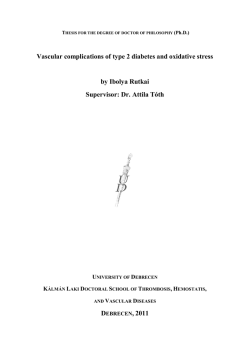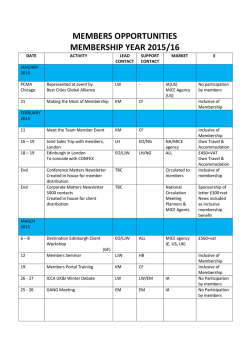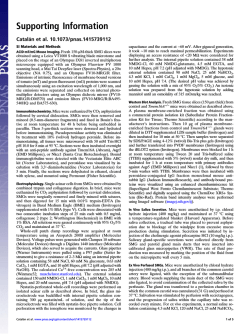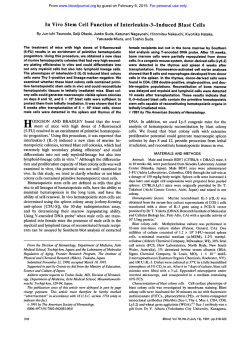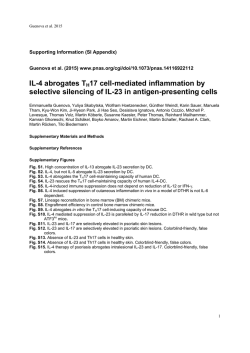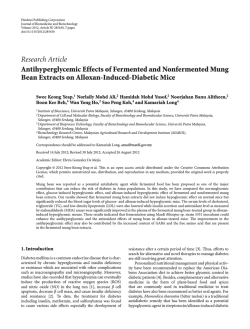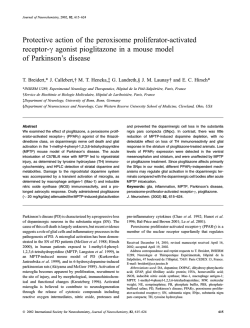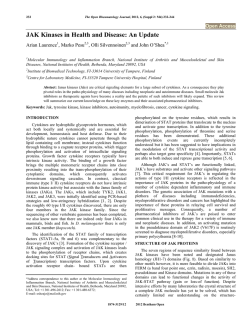
Heritable Severe Combined Anemia and Thrombocytopenia
From www.bloodjournal.org by guest on February 6, 2015. For personal use only. Heritable Severe Combined Anemia and Thrombocytopenia in the Mouse: Description of the Disease and Successful Therapy By Luanne L. Peters, Eleanor C. McFarland-Starr, Bonnie G. Wood, and Jane E. Barker A new autosomal recessive mouse mutation, scat (severe combined anemia and thrombocytopenia), causes intermittent episodes of severe bleeding in the homozygote. At birth, affected mice are pale with intradermal petechiae and bruises on exposed surfaces. Central nervous system (CNS) bleeding occurs in 22% of the mice. Gastrointestinal (GI) hemorrhaging and splenomegalyare noted in moribund mice at autopsy. Of the 291 mice studied, 113 mice survived the initial crisis and entered a spontaneousremission period lasting from day 16 to day 27. A second crisis period ensued, and all but 22 mice died by 45 days. Mice in crisis show significantly decreased platelets, erythrocytes, and leukocytes and increased reticulocytes when compared to normal littermates. During remission all parame- ters are significantly improved or revert to normal values. Neither splenomegaly nor internal bleeding are observed during remission. A platelet-specific antibody is present in the plasma of mutant mice during crisis. The symptoms (severe bleeding, anemia, low-platelet counts) and plateletspecific antibody production are transferred to lethally irradiated normal mice through spleen cell transplantation. Splenectomy of mice in remission significantly increases survival. Exploitation of the features common to both scat/scat mice and patients with some forms of autoimmune thrombocytopenic purpura will undoubtedly prove useful in defining common pathways of disease development and in testing potential therapeutic measures. 0 1990 by The American Society of Hematology. E from autoimmune N Z B / B l N J - + / + ( N Z B ) mice were used as positive controls during immunoblotting. The Jackson Laboratory is fully accredited by the American Association for Accreditation of Laboratory Animal Care. Survival studies, gross pathology. and histopathology. The average life span of the mutant animals and the temporal progression of the disease state were determined by daily observations of 291 BALB-scatlscat mice for 60 days or until death occurred. The mice were classified as being in crisis or in remission based on overt symptoms. Mice in crisis were extremely pale, had bruised extremities, and occasionally had accumulation of blood in the dorsal cranial area. Additional scat/scat mice not included in this study were killed by cervical dislocation and autopsied as they became moribund. Comparisons were made between mutant mice and age-related BALB-+/ + mice killed at the same time. For histologic examination, tissues were fixed in Tellyznicksky’s fixative (thymus, lung, lymph nodes, spleen, liver, kidney, and adrenal glands) or 10% nonbuffered formalin (femur), embedded in paraffin, and sectioned at 3 pm. Femurs were decalcified in Cal Ex (Scientific Products, McGaw Park, IL). Sections were stained with Mayer’s hematoxylin and eosin (H and E), periodic acid-Schiff reagent (PAS), methyl green pyronin (MG/P), or Gomori’s iron stain. Tissues for plastic sections were fixed in 0.3% glutaraldehyde0.5% paraformaldehyde in 0.05 mol/L PIPES buffer at pH 7.35,’O Sections were stained with benzidene dihydrochloride. XPERIMENTALLY produced immune platelet destruction in laboratory animals has been used to study the effects of thrombocytopenia on megakaryocytopoiesis and thrombop~iesis.’.~ While such models permit analysis of in vivo platelet destruction and its consequences, they reveal little about its etiology. Recently, a new recessive mutation called scar (severe combined anemia and thrombocytopenia) occurred in the BALBIcBy mouse strain. In homozygous mice, presence of an antibody to a 110-Kd platelet protein coincides with a cyclical platelet insufficiency. The disease, including its immune component, is transferable through the hematopoietic stem cells. In this regard the scat mutation resembles known murine lupus models, including the NZB, BXSB, and M R L strains, which are also transferable through the stem cell^.^-^ In these strains, antiplatelet antibodies have not been implicated in the pathogenesis of the respective autoimmune syndromes. In scatlscat mice, however, antiplatelet antibodies appear to be a primary cause of the symptoms produced by the gene defect. The scatlscnt mice share a number of disease symptoms and the presence of a platelet-specific antibody with patients suffering from some forms of autoimmune thrombocytopenic purpura (ITP). The current paper provides the first description of the defects in the mouse mutant, the transmission of the disease through the hematopoietic stem cells, and the development of one prophylactic measure. MATERIALS AND METHODS Animals. BALB/cBY (BALB)-scatlscat mice were discovered and maintained at The Jackson Laboratory. Female mutant mice were unable to survive pregnancy. As a consequence, the mutant mice were generated either by mating BALB-scar/+ parents or by transplanting ovaries from mutant females to congenic C.B. Hbb” female mice and mating the ovary recipients to BALB-scat/ + males.’A difference at the albino locus permitted recognition of mice generated from the resident C.B.Hbb” oocytes and the transplanted BALB oocytes. Progeny from the C.B.Hbb” oocytes were brown agouti, while progeny from the BALB oocytes were albino. The extreme pallor, bruises, and intradermal petechiae at birth easily distinguished the scatlscat mice from their normal BALB littermates. Age-related BALB-+/+ mice generated from BALB-+/+ mating pairs were used as controls. Congenic C.B.Hbb5mice were recipients in the transplantation studies. Erythrocytes and plasma Blood, VOI 76, NO4 (August 15). 1990: pp 745-754 From the Jackson Laboratory, Bar Harbor, ME; and the Department of Zoology, University of Maine, Orono, ME. Submitted November 3,1989; accepted April 26,1990. Supported by a Graduate Student Board Research Grant from the University of Maine (L.L.P.),a University of Maine Faculty Research Grant (B.G.W.). and Grants No. DK 27726 (J.E.B.) and HL 29305 (J.E.B.)from the National Institutes of Health. The National Institutes of Health is not responsible for the contents of this publication nor do the contents necessarily represent the oficial views of that agency. A preliminary report of this research has been published in abstractform (Blood, 72:335a, 1988 [suppl 1. abstr 1250]). Address reprint requests to Luanne L. Peters. PhD. The Jackson Laboratory, 600 Main St, Bar Harbor, ME 04609-0800. The publication costs of this article were defrayed in part by page charge payment. This article must therefore be hereby marked “advertisement” in accordance with 18 U.S.C.section 1734 solely to indicate this fact. 6 I990 by The American Society of Hematology. 0006-4971/90/7604-O01 8$3.00/0 745 From www.bloodjournal.org by guest on February 6, 2015. For personal use only. 746 Peripheral blood studies. Blood counts in mice are dependent For this reason, upon the method and time of blood whole blood was withdrawn from the retro-orbital sinus between 1200 and 1400 hours. Erythrocytes were counted using a CoulterCounter Model ZBI. Leukocyte and platelets were counted by light microscopy using conventional manual methods.I3 For differential leukocyte counts, blood smears were prepared and stained with Wright’s-Giemsa using an automatic Hemastainer (Geometric Data Corporation). Differential counts were performed on 100 cells to obtain the relative numbers (percent) of circulating lymphocytes and granulocytes. Absolute counts were calculated by multiplying the total white blood cell (WBC) count by the relative count. Reticulocyte percent was determined from direct counts of blood cells exposed to new methylene blue.I4 Serum bilirubin determinations. Serum total-bilirubin levels were determined by the Malloy-Evelyn method.I5 Urine screening. Qualitative urine hemoglobin and bilirubin levels were determined using Ames Multistix 10 SG test strips. Urine for microscopic analysis was obtained from the bladder using a 30-gauge needle and examined by light microscopy using a 40x objective for the presence of red blood cells (RBCs). Indirect Coombs tests. RBCs from heparinized whole blood obtained from the thoracic cavity of mice anesthetized with avertin were washed four times and resuspended at 5% in normal saline (0.9% NaCL in H,O). The cells were incubated 1:l with ficin (Cooper Biomedical) for 10 minutes at 37OC, washed in saline, and again resuspended to a 5% solution in saline. RBCs, autologous plasma, and 22% albumin (Ortho) in a 1:2:2 ratio were incubated for 30 minutes at 37OC, centrifuged for 5 minutes at 138g, and read for agglutination both macroscopically and microscopically. Preparation of erythrocyte ghost membranes. Hemoglobin-free erythrocyte membrane ghosts were prepared by the method of Dodge et a1.I6 The amount of protein in the preparation was determined by the method of Lowry.” The ghosts were dissolved in 4x Laemmli bufferla and boiled for 5 minutes before storage at - 2OoC and/or before electrophoresis on polyacrylamide gels. Preparation of solubilized platelet proteins. Platelets were obtained from adult (6 to 8 weeks) BALB-+/+ mice. The mice were anesthetized with avertin and blood from the thoracic cavity was collected in 3.8% sodium citrate in saline. Plasma was removed by centrifugation of the cells at 480g. The cells were washed two to three times in saline to remove residual plasma. A platelet-rich suspension in saline was obtained by a final centrifugation at 120g for 20 minutes at 4OC. Platelets in the supernatant were adjusted to 2 x 108/mL and collected by centrifugation at 11,OOOg in a Brinkman Eppendorf 5415 microcentrifuge. The pellets were washed and vigorously vortexed in distilled water two times. The final pellet was solubilized by addition of 50 pL of distilled H,O, 50 pL of 10% sodium-dodecyl sulfate (SDS), and 50 pL of 4 x Laemmli buffer. The solubilized platelets were boiled before storage at -2OOC and/or before electrophoresis. Electrophoresis on denaturing polyacrylamide gels. SDS-polyacrylamide gel electrophoresis (SDS-PAGE) of red cell ghost proteins and of solubilized platelet proteins was performed by the method of Laemmli.I8Erythrocyte ghost proteins (125 pg) or 50 pL of solubilized platelet proteins were loaded in each sample well. Molecular weight standards (myosin [200,000 D], beta galactosidase [116,250 D], phosphorylase B [97,400 D], bovine serum albumin [BSA, 66,200 D], and ovalbumin [42,699 D]) were applied to one lane as markers. Electrophoresis was continued for 5 hours at a constant current of 40 mA or overnight at 8 mA. The proteins were either stained with Coomassie blue’’ or transferred to nitrocellulose for Western analyses.20,21 Western blot analyses. Heparinized whole blood was obtained PETERS ET AL from the thoracic cavity under avertin anesthesia. Untreated plasma or plasma precipitated with antimouse IgG (Sigma, St. Louis, MO; M8890) overnight at 4°C was tested for erythrocyte and platelet autoantibodies. A nitrocellulose filter with red-cell or plateletmembrane proteins was placed in buffered saline (20 mmol/L TRIS, 500 mmol/L NaCl, pH 7.5) for 20 minutes and blocked in 3% gelatin in buffered saline with 0.05% Tween-20 for 1 hour at room temperature. The filter was rinsed in buffered saline containing 0.05%Tween-20 and incubated for 2% hours in serum diluted 150 to 1:lOO in 1% gelatin in Tween-20 buffered saline. The filter was washed two times in Tween-20 buffered saline, incubated with goat antimouse IgG (heavy and light chains) horseradish peroxidase conjugate (Bio-Rad, Richmond, CA) for 1 hour, washed and immersed in 0.3% horseradish peroxidase color development reagent (4-chloro-1-naphthol, Bio-Rad) in cold methanol with 0.02% H202 in buffered saline for 5 to 30 minutes. Bone marrow transplantation. At least 2 x lo6 spleen cells retrieved from mutant mice in crisis were transplanted intravenously (IV) into C.B.Hbbs mice with an LD” dose (700 R) delivered from a ”?Cs gamma irradiator at a dose rate of 220 rads/min.*, The difference at the beta globin locus, Hbb, allowed measurement of donor cell contribution to the host. Hemoglobin phenotype was determined on blood lysates by the technique of W h i t n e ~ Blood .~~ and plasma were obtained from moribund mice for the various analyses. Splenectomy. Animals were splenectomized using standard technique^.^^ Statistical analyses. Numerical results were analyzed by Tukey’s test for significance of difference between mean values and analysis of variance (ANOVA) or the two-tailed student’s t test.25All data expressed as percentages were transformed prior to statistical analysis. Survival studies were analyzed by the xz test.26 RESULTS Progeny testing. The scat mutation was inherited in a recessive fashion. Breeding of known heterozygotes, derived from matings of C.B.Hbb”females carrying scatlscat ovaries to BALB- / males, resulted in the appearance of affected newborns. Crosses between BALB-scat/ and BALB- / mice never produced affected offspring. In heterozygous matings, approximately 18% of live offspring were affected, suggesting some death in utero occurred. The chromosomal location of the scat mutation has not yet been determined. Survival studies and gross pathology. Newborn BALBscatlscat mice were monitored daily for a period of 60 days or until death occurred (Fig 1). All the homozygous mice were pale at birth and showed bruising and petechiae. Twenty-two percent of the mice developed intracranial bleeding. Of the 291 mice studied, 178 (61.2%) died by 25 days without entering a remission stage. The remaining mice went into a spontaneous remission period in which all overt symptoms had completely disappeared by day 16. On average, this remission period lasted 11 days, ending a t day 27. During the second crisis, 91 mice (31.3%) died while 22 (7.5%) recovered and entered a n extended remission period free of all symptoms. These animals were not monitored more than 60 days. Of the mutant mice studied, 90% were dead by 50 days, with a mean survival time of 22 days. T h e mean life span of BALB-+/ + mice is greater than 18 months.27 Gross pathology a t autopsy revealed extensive gastrointestinal (GI) and rectal bleeding. There was marked spleno- + + + ++ From www.bloodjournal.org by guest on February 6, 2015. For personal use only. 747 HERITABLE ANEMIA AND THROMBOCYTOPENIA IN MICE L 3 aI 8 *OI 0 10 20 30 40 50 60 70 age (days) Fig 1. The survival of swr/scar mice as a function of age. Data is based on the daily observation of 291 animals. megaly (Table 1). Mice killed during remission periods showed no internal bleeding and the spleen size was normal. Thymus, kidney, lung, lymph node, and adrenal glands from scatlscat mice in crisis appeared histologically normal. Hemosiderin deposits were not observed in mutant animal tissues during crisis episodes using Gomori's iron stain. Spleens of scatlscat mice in crisis showed increased mature megakaryocytes and a proliferation of large mononuclear cells that completely effaced the normal splenic architecture (Fig 2A through C). Lymphatic nodules and blood sinuses were conspicuously reduced or absent. The mononuclear cells were characterized by a large, pale nucleus with dispersed chromatin and a small amount of cytoplasm (Fig 2D through F). Mitotic figures were frequent. Spleens of scatlscat animals in remission were histologically normal. Benzidine positive cells were absent or present only in small numbers in scatlscat crisis spleens, whereas a strong reaction was evident, as expected, in the red pulp areas of +/ + and scat/scat remission spleens. No proliferation of plasma cells or Mott cells could be found using MG/P or PAS staining and conventional morphological criteria in any of the sections studied.28 Animals in crisis showed foci of mononuclear cells in the perivascular areas of the liver (Fig 2G). Mitotic figures were commonly seen in these foci. Whether these cells are derived from or are similar to those of the spleen is unknown at present. No other organs showed any cellular infiltrates such as those found in the liver. Liver sections from animals in remission did not differ histologically from + / + animals. Examination of femurs showed increased megakaryocytes in scatlscat mice in crisis when compared to either + / + or scat/scat mice in remission (Fig 2H and I). The cellularity appeared normal in most cases, although moribund animals frequently showed increased fat deposition in the marrow. Peripheral blood. The extreme pallor of the mice in crisis was indicative of a severe anemia. Anisocytotic and poikilocytotic erythrocytes were noted in blood smears from crisis mice, and there were frequent burr cells, schistocytes, and acanthocytes, and markedly increased numbers of poly- chromatophilic erythrocytes (Fig 25 through L). RBC counts from 17 mice in crisis at 20 to 26 days postnatally averaged 2.62 x 10l2/1 2 0.24 x 10"/1 (mean f SEM). Countsfrom 16 normal-appearing littermates averaged 8.88 x 10l2/1 0.29 x 10L2/1.Hematocrits from 34 mice in crisis were 15.8% f 1.3%, while those from 8 mice in remission were 41.4% f 2.6% and were similar to the mean value of 42.6% f 0.9% from 32 normal mice. The absolute reticulocyte count was increased from 0.81 x 10t2/Lf 0.08 x 10l2/L in normal mice (n = 12) to 1.97 x 10I2/L + 0.15 x 10'2/Linscat/scat mice in crisis (n = 8). f i e intradermal petechiae, bruising, and anemia noted at birth and during crisis periods were suggestive of a severe bleeding disorder. Bleeding times were noted to be increased in scatlscat mice during routine retro-orbital bleeding or when obtaining blood from tail veins. Clotting in both cases occurred almost immediately (less than 5 minutes) in BALB+ / + mice, whereas BALB-scat/scat mice required cauterization of tail veins. In the case of retro-orbital bleeding, BALB-scatlscat mice usually bled to death. Subsequent to this observation, retro-orbital bleeding, when performed in BALB-scatlscat mice, was immediately followed by euthanasia. Prolongation of bleeding time suggested a platelet deficiency. The mutant mice were severely thrombocytopenic during crisis periods (Fig 3). During remission periods, complete (males) or near-complete (females) recovery occurred. On blood smears there was no evidence of platelets in crisis mice, although platelets were present and appeared normal in mice in remission (Fig 2K and L). Total WBC counts indicated that crisis mice were severely leukopenic (Table 2). During remission periods, female WBC counts did not differ from normal controls, while male WBC counts improved but remained significantly (P< .OS) less than that in normal males. Differential counts of blood smears showed an increase in the percentage of granulocytes and a decrease in the percentage of lymphocytes. Absolute counts based on these values indicated a severe lymphopenia that persisted in remission males but not females. Monocytes and eosinophils consistently represented 1% to 5% of the peripheral blood white cells and did not differ among the mice studied. Serum bilirubin levels and qualitative urine screening. Serum bilirubin levels did not significantly differ between BALB-scatlscat mice in crisis and BALB- + / + controls. For 2- to 4-week-old scat/scat mice in crisis, total serum bilirubin levels were 13.2 pmol/L f 1.7 pmol/L (n = 9) compared to 10.1 pmol/L f 1.7 pmol/L (n = 5) for +/+ mice of the same age. Qualitative urine screening showed no increase in urinary bilirubin in scatlscat crisis mice. Increased urine Table 1. Spleen Weight Genotype Phenotype No. Mice +I+ Normal Crisis Remission 33 scat/scar scat/scat 14 12 Values are mean i SEM. * P< .05 versus normal and remissionanimals. Weight of Spleen I% body weight) 0.65 i 0.05 3.00 & 0.20. 0.60 i 0 . 1 4 From www.bloodjournal.org by guest on February 6, 2015. For personal use only. 748 Pl3ERSlTM From www.bloodjournal.org by guest on February 6, 2015. For personal use only. HERITABLE ANEMIA AND THROMBOCYTOPENIA IN MICE Uj B males 0 females (25) + + Fig 3. Platelet (PLT) counts in normal ( / 1 and scat/scat mice in crisis (Cr) and in remission (Rem). Numbers in parentheses indicate the number of mice analyzed; bars indicate the SEM. .indicates a P <.05 when scat/scat mice in remission are compared with / mice; **, a P <.05 when scat/scat mice in crisis are compared with both mutant mice in remission and / mice. + + + + hemoglobin could be detected using Ames Multistix reagent strips; scatlscat mice in crisis frequently gave 3+ reactions, while normal mice showed a trace a t most. When urine was examined under the microscope, intact RBCs were abundant (greater than 20/hpf) in scatlscat crisis but not +/ + mice. Examination of serum for autoantibodies. In six of nine trials, plasma from mice in crisis caused a diminution of platelet numbers when injected into the tail veins of BALB+/+ mice (Fig 4). At 90 minutes postinjection, platelet counts ranged from 62% to 83%of baseline values. N o effect was seen in any of six recipients of control (BALB-+/+) plasma. N o effect on erythrocyte morphology was detected in any of the recipients. Indirect Coombs' tests were negative for mice in crisis (n = 6), further suggesting that the effect of plasma injection was limited to platelets. By indirect Coombs' testing, erythrocyte autoantibody was easily detected in aged N Z B (n = 3) positive controls. To determine whether the platelet inhibitory factor was an autoantibody, plasma from BALB- + / +, scatlscat mice in crisis and in remission, and positive control plasma from the autoimmune N Z B mice was reacted with erythrocyte membrane and/or platelet proteins affixed to nitrocellulose. All plasma samples were tested against autologous erythrocyte ghost proteins. In eight trials no circulating erythrocyte autoantibodies were detected in plasma from the mutant mice or from BALB-+/+ mice (Fig 5). Plasma from autoimmune N Z B mice gave strong positive reactions to 749 NZB, BALB-scatlscat and - + / + erythrocyte membrane proteins. For detection of platelet-specific antibodies, it was necessary to react both BALB-+/ + and scat/scat plasma against BALB- + / + platelet proteins, since insufficient scatlscat platelets were available for platelet membrane preparations and electrophoresis. Our assumption was that a plateletspecific antibody, if present in scatlscat mice, would cross react with normal platelet proteins. A specific BALB- + / + platelet membrane protein gave a strong positive reaction with plasma from 12 of 14 scatlscat mice in crisis (Fig 5). In each case the platelet protein had an apparent mol wt of 110 Kd. There was no reactivity with the 110-Kd protein when the filters were probed with plasma from BALB- + / + mice (n = 1 1). Of five scat/scat remission mice tested, one showed a weak positive reaction and four were negative. The probability that the antibody is an IgG moiety is enhanced by the observation that scatlscat crisis plasma precipitated with anti-IgG no longer recognizes the 1 IO-Kd platelet protein. Disease transmittance through spleen cell transplantation. To determine whether the disease is intrinsic to hematopoietic progenitors, spleen cells from mice in crisis or from normal mice were transplanted into lethally irradiated + / + C.B.Hbb" congenic hosts. All the recipients assumed the complete hemoglobin phenotype of the mutant mice 3 to 8 weeks after transplantation. The recipients of scat/scat cells but not + / + cells all displayed overt symptoms of the scat gene defect in an episodic manner within 8 weeks. Animals were autopsied as they became moribund (3 to 11 weeks post-transplantation). When compared to mice receiving + / + cells (autopsied at 8 to 11 weeks post-transplantation), mice receiving scatlscat cells had significantly increased spleen size and significantly decreased peripheral blood counts that exactly paralleled the changes seen in scatlscat crisis versus + / + animals (Table 3). In addition, the spleen and liver histology and RBC morphology were altered such that they took on the scatlscat crisis appearance (Fig 6A through C). N o change in spleen histology or erythrocyte morphology was seen in mice receiving +/+ cells. Western analyses detected antibody to the 1IO-Kd platelet protein in 60% of the scatlscat recipients (not shown). None of the mice receiving +/ + cells demonstrated any antiplatelet antibody. The results indicated that the disease was transmitted by mutant spleen cells into irradiated +/ + congenic hosts. Effects of splenectomy on disease genesis. The splenomegaly and autoimmune aspects of the disease in scatlscat 4 Fig 2. Microscopic appearance of tissues in normal and mutant mice. (Original magnification indicated in parentheses.) (A) Spleen of a scaf/scatcrisis mouse ( x 100). (6) Spleen of a scadscat remission mouse ( x 100). ( C )Normal spleen ( x 100). The scat/scatcrisis spleen no longer shows lymphatic nodules and has increased numbers of megakaryocytes. (D and E) Enlargements of spleen sections of scar/scat crisis mice showing the large, proliferating mononuclear cells that efface the normal splenic architecture ( x 1.OOOl. (F) Section of a normal spleen through the center of a lymphatic nodule ( x 1,OOO). Note the smaller size of the cells compared with the scaf/scaf crisis spleen. (G) Perivascular focus of cells in the liver of a scaf/scat crisis animal (~400). A group of cells of unknown origin is located immediately left of a liver microcapillary. (H) Femur from a scaf/scafmouse (~400). (1) Normal femur (~400). Note the increased number of megakaryocytesin the scaf/scat crisis femur. (J) Peripheral blood smear taken from a normal mouse (x1,OW). (K) Peripheral blood smear taken from a scadscat mouse in remission (x1,OOO). (L)Peripheral blood of a scadscat crisis mouse ( x 1,OOO). The erythrocyte morphology is grossly abnormal and platelets are completely lacking in the scat/scat crisis mouse. From www.bloodjournal.org by guest on February 6, 2015. For personal use only. 750 PETERS ET AL Table 2. WBC Counts in Normal and scat/scat Mice in Crisis and in Remission Group (No.) Absolute Granulocyte Count wBC Count (x~o’/L) Granulocytes (%) 13.8 f 0.5 15.5 f 1.3 2.2 12.5 f 2.1 4.2 & 4.0t 15.2 f 2.1 43.4 f 4.0t 11.6 f 0.3 LvmDhocvtes (%) Absolute Lymphocyte Count (X1 0 ~ ~ 1 Females +/+ (291 scat/scat Rem (5) Cr (13) * 0.2 82.2 1.8 0.3 2.2 f 0.8 * 82.4 f 2.8 53.8 4 . l t 18.7 f 1.4 2.2 f 0.2 79.1 f 1.5 9.3 20.9 44.6 1.7 f 0.2 1.5 f 0.2 70.2 f 3.2 50.6 f 7.1 t 5.7 f 0.6+ 2.0 f 0 . 5 t f 1.4 11.4 f 0.4 10.5 k 1.9 2.3 f 0.4t Males +/+ (25) scat/scat Rem ( 8 ) Cr ( 8 ) 8.1 f 0.6+ 3.4 f 0.5t f f 1.6 7.7t 0.3 Values are mean f SEM. Abbreviations: Cr, crisis; Rem, remission. * P < .05 versus +/+. t P < .05 versus +/+ and scat/scat Rem. mice in crisis suggested that splenectomy might be a therapeutic measure. Splenectomy was performed in 14 mutant animals. All animals were in remission at the time of surgery as judged by overt symptoms and peripheral blood WBC and PLT counts. Twelve of the mice (86%) survived at least 60 days without any overt indications of disease. Five healthy mice with no sign of bruises or petechiae were killed a t 60 days. Before death, peripheral blood counts revealed normal hematocrits and platelet counts, normal WBC counts, normal differential counts and normal reticulocyte counts (Table 4). Of those mice remaining, all survived for longer than 10 months without ever showing scat symptoms. 0 I I I 30 60 90 Time (minutes) + + Fig 4. Platelet (PLT) counts (&SEMIin normal / mice after or scat/scat Cr plasma injection with 0.1 cc / plasma 1-( (x-x). Only those animals that responded the injection of scat/sc8t Cr plasma (six of nine) are shown. + + The survival data (12 of 14 splenectomized mutant mice survived in remission for at least 60 days compared to 22 of 291 unperturbated mutant mice that had survived in remission for 60 days) indicated that splenectomy significantly (P< .005) improved survival of the mutant mice. Screening of normal littermates. Unaffected offspring (scat/?)of scat/ + mating pairs were overtly normal; scat/ + (50%) pups could not be distinguished from + / + (25%) pups a t birth or subsequently. To determine if scat/+ littermates could be identified by other parameters, 17 normal-appearing littermates taken from litters in which at least one affected animal was produced were compared to age-related + / + mice born of BALB- + / + mating pairs. The normal-appearing littermates did not differ from + / + offspring of + / + parents in WBC, platelet, reticulocyte, or differential counts or in erythrocyte morphology or hematocrit values (data not shown). Also, two populations of normal littermates representing scat/ +, and + / + genotypes were not evident. In terms of spleen weights, however, offspring of scat/+ mating pairs had consistently and significantly (P< .05) increased spleen sizes compared to offspring of + / + mating pairs. The spleen weight, as percent body weight, was 1.02 0.03 for scat/? mice and 0.73 f 0.03 for + / + mice. The absolute spleen weight was also significantly (P< .05) elevated in scat/? versus + / + mice (data not shown). Histologically no abnormalities in the spleens of scat/? animals could be identified by light microscopy, indicating that the changes at this stage were subtle. Western analysis for platelet antibody was negative in all 17 normal appearing offspring of scat/ + mating pairs. DISCUSSION The results presented here indicate that scatlscat mice suffer from an immune disorder. The presence of an antibody specific for a 110-Kd platelet protein in mice that are platelet deficient suggests cause and effect. The platelet insufficiency is manifested in low platelet counts and a lack of platelets on peripheral blood smears. (Manual platelet counts are falsely From www.bloodjournal.org by guest on February 6, 2015. For personal use only. HERITAELE ANEMIA AND THROMEOCnOPENIA IN MICE 76 1 Fb5. W m t u n b k t ( i n g t e d . N c t ~ o u toombadin. Nltrocdh~k..likmconutning / (lono 1) ond scmt/.ur (hno2) orvthrocytoghoots protoins w u o probod with plomu from an NZE mouu (NZEI. plowno from a scmt/scmt mouu in aisir ( L u r Cr). or plouru from a scmt/scmt m o u ~ in romiu&n [#car Run). Nitrocolluk.. fikrr contoining plotdot protdnr from + / + mko (lonos 3 through 6) w u o pra4ul with plouru from 0 #cat/ scmt mouu in a h i r ( . u t Cr). plowno from 0 scmt/scmt mouoo in rominion ( . u t Run). or plouru from 0 + / + nwn~80( + / + 1 . Tho posttivo bond s p o tho ~ width ol tho wdl in tho . u r / . u t Cr hno ond is opproxinutoty 110 Kd. + + afTected mice are frequently weanling. This suggests antibody is produced in situ rather than transferred from the mother at thisstage. Autoantibodies to specific platelet membrane glycoproteins (GP) are present in some humans with autoimmune thrombocytopenic purpura.” In many cascs such antibodies appear to be directed against human GP Ib and GP Ilb/ llla.”’ In the present study antibodies to the as yet unidentified I IO-Kd platelet membrane protein were detected in the plasma of I2 of 14 scut/scu~mice. Plasma from normal mice was consistently negative, and only one mouse classified as being in remission displayed reactivity. Initial tests showed that nonspecific protein binding occurs at plasma dilutions of 5 1:40 in all groups (data not shown). Hence all samples were diluted at least 150 in this study. Similar problems in obtaining low background using human material have been encountered with both serologic and immunoblot methods.’4.” In addition. as was the case with two scut/scur mice tested by immunoblotting and three tested by serum injections. circulating antiplatelet antibody is not always detectable in humans with ITP using either Western analysis or other methods.’O.Y” elevated by the presence of many microerythrocytes and unlysed erythrocytes with numerous membrane spicules.) The onset of the disease at birth is difficult to explain. since the immune system of the newborn is not yet fully developed. Recently we investigated the possibility that maternal antibodies are involved in the etiology of the defect. Plasma from pregnant scar/ + but not from virgin scur/ + mice is, in fact, positive for platelet antibody by Western blotting (paper in preparation). The etiology is suggestive of a platelet-limited transplacental-mediated disease in the scur/scur mice. The initial crisis in scur/scuf newborn mice may be due to maternal antibody crossing the placenta. The observation that spleen weights are increased in normal-appearing littermates of scur/scur mice further s u p ports the hypothesis of a maternally mediated efTect. Our Western blot results and plasma injection data clearly show that the antibody present in scur/scur crisis mice crossreacts with normal platelets. Hence. one could predict that the increased spleen size in normal littermates (apparently regardless of genotype) represented a response to an antibody that was present in utero and then cleared after birth. The second crisis period is not so easily reconciled. since the - T.bk3.80k.n(UI..ndP~lBkod~.tAutopryk,+/+C.I).~ConOMio~A*.rL.rtullmdinionuwl A.popu(nknwith8c8r/.crtor +/+ 8pk.nC.lh bb” U T m Injmd(N0.) Bp*mwJghc pM**cQm IXBodvWadw) H m ” l % l (xl0’’A) 48.2 t 0.7 30.0 i3.4. 1.35 t 0.04 +/+ (3) 0.43 I 0.02 W s w r ( 9 ) 1.41 t 0.43. = V d u e r m m ~ SEM. .PC .06MnrP + I + . 0.034 I 0.006. WBCcQm (xlO*A) * 14.6 1.4 9.4 t 2.4. *kolua LP@=V- cimJaVarl’16) bunt(xlO*A) LymphocYllI) buniIxlO’A1 14.3 46.3 2 2.0 - 5.1. * 2.1 0.4 4.0 I 1.3 84.3 t 2.3 49.6 t 6.2. 12.3 t 1.2 5.0 t 1.3. From www.bloodjournal.org by guest on February 6, 2015. For personal use only. PETERS ET AI. 762 Fig& ~ ~ a ( . p k . n . n d b k n n l t r o m o n o l g l . n t o t m u t ~ t a e I t ax .l 2d m 7 a r / m 7 a r C r r p k . r , ~ m r o I n ~ Into a / C.B.Hb6. motno. R . d p k m th.u# -0 r “ d 8 W o hr.Photomkrographa(wigid-) aro of (A) .pk.n (xloo): (E) qJl0.n ~xl.OO0);and (C) p0riph.r.l Mood l xl.OO0). + + Antibodies to erythrocytes have not been detected either by immunoblotting or by the indirect Coombs’ test. During crisis episodes mice were not visibly jaundiced. Serum and urine bilirubin values did not differ from controls. In addition. no evidence of increased intravascular RBC destruction in kidney was Seen using Gomori’s iron stain. These observations suggest the anemia in the scur/scur mice in crisis is a consequence of bleeding due to the platelet insufficiency. The extreme pallor of newborn mice may result from excessive bleeding at birth. The development of misshapen erythrocytes as the mice become moribund is more difficult to understand. The scur/scur mice in crisis have grossly enlarged spleens. Unlike the human spleen, however. the mouse spleen functions as an adjunct hematopoietic organ throughout life.’* Splenomegaly in scur/.wur crisis mice could, therefore. be an indicator of compensatory erythropoiesis. However, if this were the case. splenectomy would be expected to worsen the anemia, not cure it. Furthermore. the histopathology of the spleen is not consistent with increased RBC proliferation but instead shows large mononuclear cells of unknown function. Based upon morphological characteristics. MG/P, PAS, and benzidine staining. these cells are neither erythrocyte precursors nor plasma cells. Misshapen erythrocytes may be a consequence of the altered role of the spleen in crisis mice. Further studies to characterize the spleen cell population in scur/scur mice are underway. The primary cause of the murine disease is not clear. It is possible that the disease symptoms in the scur/scur mice are related loa spleen-limited neopla~m.”.~ It is noteworthy that such neoplasms in human beings are characterized by a lack of lymph node involvement. but liver involvement is often noted. Autoimmune complications of both platelets and erythrocytes occur secondary to myeloproliferativeand lymphoproliferative disorders in human being^."^' The destruction of splenic architecture and accumulation of large mononuclear cells in scur/scur mice during crisis are consistent with a neoplasticsyndrome. Should such a disease exist in the mouse, one would predict the disease would be transferrable through hematopoietic “stem” cells. The fact that the syndrome is acquired by normal recipients of mutant spleen cells is consistent with the transfer of the following cell type: a spleen-derived neoplastic cell; an antibody-producingcell capable of proliferating in the host; or a cell racogniable as foreign by both host and donor. The spleen appears to be critical to the genesis of the sccond crisis. since splenectomy during the initial remission halts disease progression. One can hypothesize that splenectomy cures the disease in scur/scur mice. as in human being with ITP, by removing a site of antiplatelet antibody synthesis and/or of platelet destruction.16*’ There are a number of similarities between the murine disease and idiopathic thrombocytopenic purpura (ITP) in human beings. These include IgG-platelet antibody. mucosal bleeding. dermal bleeding (petechiae), increased numbers of megakaryocytes. and intracranial hemorrhaging.’“”’ However. the resemblance is not absolute. ITP in human beings is Tabb4. P u i p h u o l B k o d c . ( h h ~ # n / # n M k o WBccM1 p*a*ccM1 ( x 1O’AI Ix lO”A1 eanb2“(%I 20.8 t 2.9 1.24 t 0.2 23.4 t 3.9 LVmOhocVtr1%) 74.4 f 4.4 l+“ah(%I 46.0 = 0.3 Velum au “ I 2 SEM. N o d i f f a ” wen mtod b ”msb..ndfa”. .ndt h e ~ ~ p o o han b dfive mice. R.clcJocyar (%I 1.3 t 0.3 From www.bloodjournal.org by guest on February 6, 2015. For personal use only. 753 HERITABLE ANEMIA AND THROMBOCYTOPENIA IN MICE not associated with significant splenomegaly, misshapen erythrocytes, or leukopenia.50 An important point is that both diseases are characterized by circulating antiplatelet antibodies and diminution of platelet number. This means that exploration of the murine disease should uncover common developmental pathways, consequences, and prophylactic measures for platelet insufficiency diseases. ACKNOWLEDGMENT We thank Kelly Edwards and Stan Short for expert photographic services, Ann Higgins and Priscilla Jewett for preparing slides, Drs Edward Birkenmeier and Leonard Shultz for helpful comments on the manuscript, Dr Janan Eppig for assistance with the figures, and Barbara Dillon for secretarial services. REFERENCES 1. Ebbe S, Yee T, Carpenter D, Phalen E Megakaryocytes increase in size within ploidy groups in response to the stimulus of thrombocytopenia. Exp Hematol 1655,1988 2. Ebbe S, Levin J, Miller K, Yee T, Levin F, Phalen E: Thrombocytopoietic response to immunothrombocytopenia in nude mice. Blood 69:192, 1987 3. Corash L, Chen Y, Levin J, Baker G, Lu H, Mok Y Regulation of thrombopoiesis:Effects of the degree of thrombocytopenia on megakaryocyte ploidy and platelet volume. Blood 70:177, 1987 4. Jyonouchi H, Kincade PW, Good RA, Fernandes G: Reciprocal transfer of abnormalities in clonable B lymphocytes and myeloid progenitors between NZB and DBA/2 mice. J Immunol 127:1232, 1981 5. Morton JI, Siege1 BV: Transplantation of autoimmune potential. I. Development of antinuclear antibodies in H-2 histocompatible recipients of bone marrow from New Zealand Black mice. Proc Natl Acad Sci USA 71:2162,1974 6. Eisenberg RA, Izui S, McConahey PJ, Hang L, Peters CJ, Theofilopoulos AN, Dixon FJ: Male determined accelerated autoimmune disease in BXSB mice: Transfer by bone marrow and spleen cells. J Immunol 125:1032, 1980 7. Theofilopoulos AN, Balderas RS, Gozes Y, Aguado MT, Hang L, Morrow PR, Dixon FJ: Association of Ipr gene with graft-vs.-host disease-likesyndrome. J Exp Med 162:1, 1985 8. Theofilopoulos AN, Koftler R, Singer PA, Dixon FJ: Molecular genetics of murine lupus models. Adv Immunol46:61, 1989 9. Robertson GG: Ovarian transplantation in the house mouse. Proc Soc Exp Med 44:302,1940 10. Baur PS, Stacey TR: The use of PIPES buffer in the fixation of mammalian and marine tissues for electron microscopy. J Microscop 109:315, 1977 11. Russell ES, Bernstein SE: Blood and blood formation, in Green EL (ed): Biology of the Laboratory Mouse, 2nd ed. New York, NY, McGraw-Hill, 1968, p 351 12. Clark RH, Korst DR: Circadian periodicity of bone marrow mitotic activity and reticulocyte counts in rats and mice. Science 166:236, 1969 13. Brown BA: Hematology: Principles and Practices, 4th ed. Philadelphia, PA, Lea and Febiger, 1984, p 59 14. Deiss A, Kurth D: Circulating reticulocytes in normal adults as determined by the new methylene blue method. Am J Clin Pathol 53:481, 1970 15. Bauer JD: Clinical Laboratory Methods, 9th ed. St Louis, MO, Mosby, 1982, p 538 16. Dodge JT, Mitchell C, Hanahan DJ: The preparation and chemical characteristics of hemoglobin-free ghosts of human erythrocytes. Arch Biochem Biophys 100:119, 1963 17. Lowry OH, Rosenberg NJ, Farr AL, Randall RJ: Protein measurement with folin phenol reagent. J Biol Chem 193:265, 1951 18. Laemmli UK: Cleavage of the structural proteins during the assembly of the head of bacteriophage T4. Nature 227:680, 1970 19. Bodine DM IV, Birkenmeier CS, Barker JE: Spectrin deficient inherited hemolytic anemias in the mouse: characterization by spectrin synthesis and mRNA activity in reticulocytes. Cell 37:721, 1984 20. Burnette WN: Western blotting: Electrophoretic transfer of proteins from sodium dodecyl sulfate-polyacrylamide gels to unmodified nitrocellulose and radiographic detection with antibody and radioiodinated protein A. Anal Biochem 112:195, 1981 21. Towbin H, Staehelin T, Gordon J: Electrophoretic transfer of proteins from polyacrylamide gels to nitrocellulose sheets: procedure and some applications. Proc Natl Acad Sci USA 76:4350,1979 22. Lewis JP, OGrady LF, Bernstein SE, Russell ES, Trobaugh SE Jr: Growth and differentiation of transplanted W / W marrow. Blood 30601,1967 23. Whitney JB 111: Simplified typing of mouse hemoglobin (Hbb)using cystamine. Biochem Genet 16:667,1978 24. Haller JA Jr: The effect of neonatal splenectomy on mortality from runt disease in mice. Transplantation 2:287, 1964 25. Guenther W C Analysis of Variance. Englewood Cliffs, NJ, Prentice-Hall, 1964, p 43 26. Schefler WC: Statistics for the Biological Sciences, 2nd ed. Reading, MA, Addison-Wesley, 1980, p 103 27. Frith CH, Suber RL, Umholtz R: Hematologic and clinical chemistry findings in control BALB/c and C57BL/6 mice. Lab Animal Sci 30835,1980 28. Shultz LD, Coman DR, Lyons BL, Sidman CL, Taylor S: Development of plasmacytoid cells with Russell Bodies in autoimmune “viable motheaten” mice. Am J Pathol 127:38, 1987 29. Rock G, Decary F, Tittley P, Fuller V: Electroblotting and immunohistochemical staining for identification of platelet antibodies. Br J Haematol67:437, 1987 30. McMillan R, Tani P, Millard F, Berchtold P, Renshaw L, Woods VL Jr: Platelet-associated and plasma anti-glycoprotein autoantibodies in chronic ITP. Blood 70:1040, 1987 3 1. Devine DV, Currie MS, Rosse WR, Greenberg CS: PseudoBernard-Soulier syndrome: thrombocytopenia caused by autoantibody to platelet glycoprotein Ib. Blood 70:428, 1987 32. Szatkowski NS, Kunicki TJ, Aster RH: Identification of glycoprotein Ib as a target for autoantibody in idiopathic (autoimmune) thrombocytopenic purpura. Blood 67:310, 1986 33. Tomiyama Y, Kurata Y, Mizutani H, Kanakura Y, Tsubakio T, Yonizawa T, Tarui S:Platelet glycoprotein IIb as a target antigen in two patients with chronic idiopathic thrombocytopenic purpura. Br J Haematol66:535,1987 34. Tsubakio T, Tani P, Woods VL, McMillan R: Autoantibodies against platelet GPIIb/IIIa in chronic ITP react with different epitopes. Br J Haematol67:345, 1987 35. Menitove JE, Pereira J, Hoffman R, Anderson T, Fried W, Aster RH: Cyclic thrombocytopenia of apparent autoimmune etiology. Blood 73:1561, 1989 36. Cines DB, Schreiber AD: Immune thrombocytopenia. Use of a Coombs antiglobulin test to detect IgG and C3 on platelets. N Engl J Med 300:106,1979 37. Hedge UM, Powell DK, Bowes A, Gordon-Smith EC: Enzyme linked immunoassay for the detection of platelet associated IgG. Br J Haematol48:39, 1981 38. Hummel KP, Richardson RL, Fekete E: Anatomy, in Green From www.bloodjournal.org by guest on February 6, 2015. For personal use only. 754 EL (ed): Biology of the Laboratory Mouse, 2nd ed. New York, NY, McGraw-Hill, 1968, p 247 39. Kehoe J, Straus DJ: Primary lymphoma of the spleen. Clinical features and outcome after splenectomy. Cancer 64: 1433, 1988 40. Andouin J, Diebold J, Schvartz H, Le Tourneau A, Bernadou A, Zittoun R: Malignant lymphoplasmacytic lymphoma with prominent splenomegaly (primary lymphoma of the spleen). J Pathol 155:17, 1988 41. McMillan R, Longmire RL, Yelenosky R, Smith RS, Craddock CG: Immunoglobulin synthesis in vitro by splenic tissue in idiopathic thrombocytopenic purpura. N Engl J Med 286:681, 1972 42. Duhrsen U, Augener W, Zwingers T, Brittinger G: Spectrum and frequency of autoimmune derangements in lymphoproliferative disorders: Analysis of 637 cases and comparison with myeloproliferative disease. Br J Haematol64235, 1987 43. Aghai E, Quitt M, Lurie M, Anta1 S, Cohen L, Bitterman H, From P: Primary hepatic lymphoma presenting as symptomatic immune thrombocytopenic purpura. Cancer 60:2308,1987 44. Schwartz KA, Slichter SJ, Harker LA: Immune-mediated platelet destruction and thrombocytopenia in patients with solid tumors. Br J Haematol51:17, 1982 45. Verdirame JD, Feagler JR, Commers JR: Multiple myeloma associated with immune thrombocytopenic purpura. Cancer 56: 1199,1985 PETERS ET AL 46. Ballen PJ,Segal GM, Stratton JR, Gernsheimer T, Adamson JW, Slichter SJ: Mechanisms of thrombocytopenia in chronic autoimmune thrombocytopenic purpura. Evidence of both impaired platelet production and increased platelet clearance. J Clin Invest 80:33, 1987 47. Karpatkin S, Strick M, Siskind GW: Detection of splenic antiplatelet antibody synthesis in idiopathic autoimmune thrombocytopenic purpura (ATP). Br J Haematol23:167, 1972 48. Holme S, Heaton A, Kunchuba A, Hartman P: Increased levels of platelet associated IgG in patients with thrombocytopenia are not confined to any particular size class of platelets. Br J Haematol68:431, 1988 49. Lynch DM, Howe S E Antigenic determinants in idiopathic thrombocytopenic purpura. Br J Haematol63:301, 1986 50. Karpatkin S: Autoimmune thrombocytopenic purpura. Semin Hematol22260,1985 51. Naidu S, Messmore H, Caserta V, Fine M: CNS lesions in neonatal isoimmune thrombocytopenia. Arch Neurol40:552, 1988 52. Branehog I, Kutti J, Ridell B, Swolin B, Weinfeld A: The relation of thrombokinetics to bone marrow megakaryocytes in idiopathic thrombocytopenic purpura (ITP). Blood 45:551,1975 53. Garg SK, Lackner H, Karpatkin S: The increased percentage of megathrombocytes in various clinical disorders. Ann Intern Med 77:361, 1972 From www.bloodjournal.org by guest on February 6, 2015. For personal use only. 1990 76: 745-754 Heritable severe combined anemia and thrombocytopenia in the mouse: description of the disease and successful therapy LL Peters, EC McFarland-Starr, BG Wood and JE Barker Updated information and services can be found at: http://www.bloodjournal.org/content/76/4/745.full.html Articles on similar topics can be found in the following Blood collections Information about reproducing this article in parts or in its entirety may be found online at: http://www.bloodjournal.org/site/misc/rights.xhtml#repub_requests Information about ordering reprints may be found online at: http://www.bloodjournal.org/site/misc/rights.xhtml#reprints Information about subscriptions and ASH membership may be found online at: http://www.bloodjournal.org/site/subscriptions/index.xhtml Blood (print ISSN 0006-4971, online ISSN 1528-0020), is published weekly by the American Society of Hematology, 2021 L St, NW, Suite 900, Washington DC 20036. Copyright 2011 by The American Society of Hematology; all rights reserved.
© Copyright 2025
